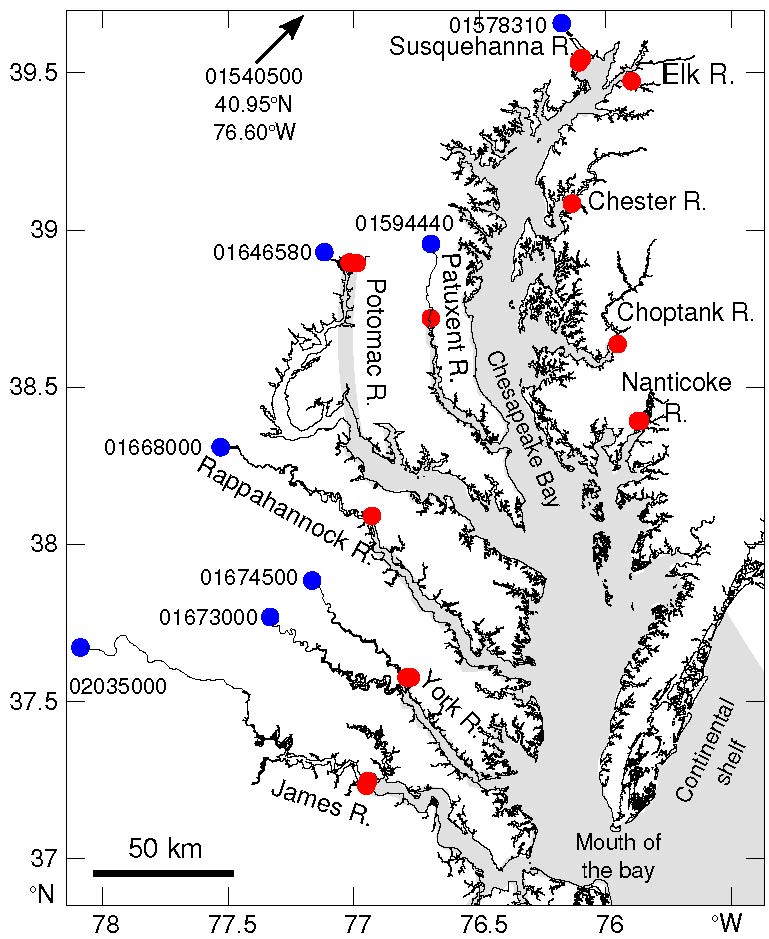By Kimberly Mann Bruch, SDSC Communications
Virginia Institute of Marine Science (VIMS) Research Scientist Pierre St-Laurent and colleagues recently used Comet at the San Diego Supercomputer Center (SDSC) at UC San Diego to examine impacts of both regional and global changes affecting the Chesapeake Bay. They discovered that historical increases in fertilizers and atmospheric carbon dioxide concentrations have forced the bay to behave increasingly like a small sea on a continental shelf rather than a traditional estuary.
“Upon studying what happened during the last 100 years, we determined that the bay now absorbs slightly more carbon dioxide than it releases into the atmosphere,” said St-Laurent. “This result exemplifies the particularity of the continental U.S.’s largest estuary, but also may be indicative of the magnitude of the changes that are ongoing in coastal waters throughout the world.”
St-Laurent and his colleagues published their detailed findings in Volume 17 (issue 14) of the Biogeosciences journal.
“Our study provides valuable perspective to watershed managers as it compares the long-term impact of fertilizer usage with other global changes,” said St-Laurent. “Not only is the health of the Chesapeake Bay important for ecological reasons, but also for economic purposes as the seafood industry driven by these waters is estimated to contribute around two billion dollars in sales each year and approximately 40,000 jobs, according to the Chesapeake Bay Foundation.”
Additionally, the bay has long been a popular tourist destination with its variety of sandy beaches, wetlands, and open waters.
“Without Comet, we would have had to scale down our experiments drastically, affecting the scientific scope of the study and leaving important questions unanswered,” added St-Laurent. “Because our research spanned two periods of time covering the early 1900s to the early 2000s, our computational requirement vastly exceeded the resources available at our local research center, but they were well within the computing capacities at SDSC.”
In addition to these long-term overview comparison models, the researchers are also interested in specifics regarding the bay’s health; specifically, they’re studying hypoxia or lack of oxygen within the waters. Their Chesapeake Bay Hypoxia Forecast, which was developed by the study’s second author and VIMS Research Professor Marjy Friedrichs, simulates present-day levels of dissolved oxygen and pH in the Chesapeake Bay, levels of dissolved oxygen and pH in the bay two days from now, and the percentage difference during that short time span.
Using this modeling system, the researchers also assess how the low oxygen waters have changed over the past 35 years. Historically the duration of low-oxygen waters in the bay has ranged between 93-143 days. Despite a general downward trend in hypoxic duration due to management actions reducing nutrient inputs to the bay, the past two years have had relatively severe hypoxia lasting 123 days in 2018 and 136 days in 2019.
“These unusually long durations of hypoxia are due to the high precipitation levels we’ve seen over the past two years,” said Friedrichs. “One of our goals with this work is to help decision makers put recent data into a long-term context so that they can better understand how their clean-up efforts are improving the health of the bay.”
As Friedrichs and St-Laurent work to refine these simulations by increasing the horizontal resolution of their model grid, resources such as Comet will be needed to continue running these long-term (35+ years) simulations.
St-Laurent and Friedrichs were funded by the National Science Foundation (OCE-1537013), the National Aeronautics and Space Administration (NNX14AF93G), and the National Oceanic and Atmospheric Administration’s National Centers for Coastal Ocean Science (NA16NOS4780207). Access to Comet was via the NSF’s Extreme Science and Engineering Discovery Environment, or XSEDE, (OCE-160013). William & Mary Research Computing also provided computational resources and technical support.
About SDSC
The San Diego Supercomputer Center (SDSC) is a leader and pioneer in high-performance and data-intensive computing, providing cyberinfrastructure resources, services, and expertise to the national research community, academia, and industry. Located on the UC San Diego campus, SDSC supports hundreds of multidisciplinary programs spanning a wide variety of domains, from astrophysics and earth sciences to disease research and drug discovery. In late 2020 SDSC will launch its newest National Science Foundation-funded supercomputer, Expanse. At over twice the performance of Comet, Expanse supports SDSC’s theme of ‘Computing without Boundaries’ with a data-centric architecture, public cloud integration, and state-of-the art GPUs for incorporating experimental facilities and edge computing.
Original post https://alertarticles.info



